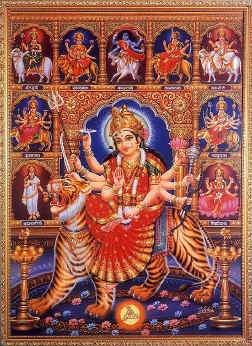
The festival of Navratri lasts for nine nights.According to the Hindu calendar Navratri celebration begins from the first day of the bright fortnight of Ashwin.This festival is fully dedicated to the worship of Goddess Durga Mata and her nine forms. These nine days are celebrated in all over the country with an ardent zeal and enthusiasm. The devotees all over India celebrated the last three days with much solemnity, calm and joy. But in the tenth day, Dussehra or Vijayadashmi is celebrated to commemorate the victory of Lord Rama over Ravana.
The festival of Navaratri is devoted to the Shakti or the Eternal Mother. This worship is so old in India even in the Vedic era. This opinion was confirmed in the vedas and puranas. The festivities commence on the first night in the month of Ashwin (October). The vibrant festivities last for ten days, of which nine nights are spent in worship, 'Navaratri'.
Navaratri are divided & devoted for the worship of Trinity of God in a female form - three days for Durga (Goddess of Energy) three days for Lakshmi (Goddess of Wealth) and three days for Sarswati (Goddess of Knowledge). On the fifth day, it is traditional to worship Sarswati Mata to invoke our sprit and knowledge. The eighth and ninth day, it is traditional to perform Yagna (sacrifice offered to the fire) to honor Durga Mata and bid her farewell. The 10th day, on which the goddess kills Mahishasura, is celebrated as Dusshera or Vijayadashami as the victory of good over evil.
Navaratri is a combination of various themes, with the common theme of the victory of good over evil. Some opines that Vijayadashami or Dusshera is celebrated on the day Lord Rama kills Ravana. According to a Puranic legend, the mighty demon Mahisasur vanquished the gods and their king, Indra. They then approached the Brahma, Vishnu and Maheshwar, who decided to destroy the megalomaniac demon, so they all combined their energy, and gave rise to Shakti.
They all prayed to the divine mother Durga to do the needful. Equipped with lethal weapons, riding a ferocious lion, the Goddess in all her awesome majesty, vanquished the evil one without much ado. The 10th day on which the goddess kills Mahishasura, is celebrated as Dusshera or Vijayadashami as the victory of good over evil.Dassera (tenth day) is one of the significant Hindu festivals, celebrated with much joie de vivre in the entire country. On the tenth day, the Vijayadasmi day, colossal effigies of Ravana, his brother Kumbhkarna and son Meghnadh are placed in vast open spaces.
Rama, accompanied by his consort Sita and his brother Lakshmana, arrive and shoot arrows of fire at these effigies, which are stuffed with explosive material. The result is a deafening blast, enhanced by the shouts of merriment and triumph from the spectators. It is significant that the Lord invoked the blessings of the divine mother, Goddess Durga, before actually going out to battle. In burning the effigies the people are asked to burn the evil within them, and thus follow the path of virtue and goodness, bearing in mind the instance of Ravana, who despite all his might and majesty was destroyed for his evil ways. On this dayin the famous Ramleela grounds in Delhi huge effigies of the ten-headed demon king Ravana, Meghanath, his son, and Kumbhakarna, his brother, stuffed with crackers are torched by an arrow to symbolize the ultimate triumph of good over evil.
The festival is also celebrated with intense fervour and zest, in whole India, in the form of Durga Puja. The vibrant festivities last for ten days, of which nine nights are spent in worship, 'Navaratri'.But this festival varies from place to place.
The most famous Navaratri celebrations are held on the western states of India (Gujarat and Maharashtra) in the form of Dandiya and Garba dances. In the time of dancing the dancers are moving around in a circle, with different steps around a lamp, which represent the Eternal Light of the Durga Mata. Generally Gujarati women dance around the circles by clapping their hands or decorated sticks to the rhythm of the devotional songs. After worshipping and 'Aarti', 'Dandiya raas' is performed all through the night.
In West-Bengal, Navaratri is the real lyrics of the Bengali life. This festival is essentially religious in nature. It is celebrated with true devotion. In the time of Durga Puja huge idols of the Mata Durga posed as killing the demon Mahishasura are worshipped in everywhere of the state. Huge
'pandals' are set up every where to worship Durga Mata (Goddess Durga). The tenth day is devoted to the worship of goddess Durga. She is Shakti, the cosmic energy that animates all beings. Beautiful idols of the Mother Goddess are worshipped in elaborate pandals for nine days, and on the ninth day, these are carried out in procession for immersion (visarjan) in a river or pond.
In Maharashtra, navaratri celebration is slightly different than other states. Here Navratri are dedicated to Goddess Durga while the Vijayadashami is dedicated to Saraswati, the goddess of knowledge. This day is considered auspicious to begin education, buy new homes, start new ventures, and weddings.The Dasara of Mysore is also quite famous where caparisoned elephants lead a colourful procession through the gaily-dressed streets of the city. During Navaratri Chamundi, the royal deity of the Mysore royalty is worshipped with pomp and pageantry.
Like other festivals in the country, Navratri is a festival that combines spiritual, cultural and frivolous activities for almost a fortnight. So it is really an occasion for festivities on a grand scale, which emanate a genuine feeling of bonhomie and warmth.




No comments:
Post a Comment